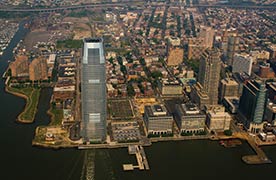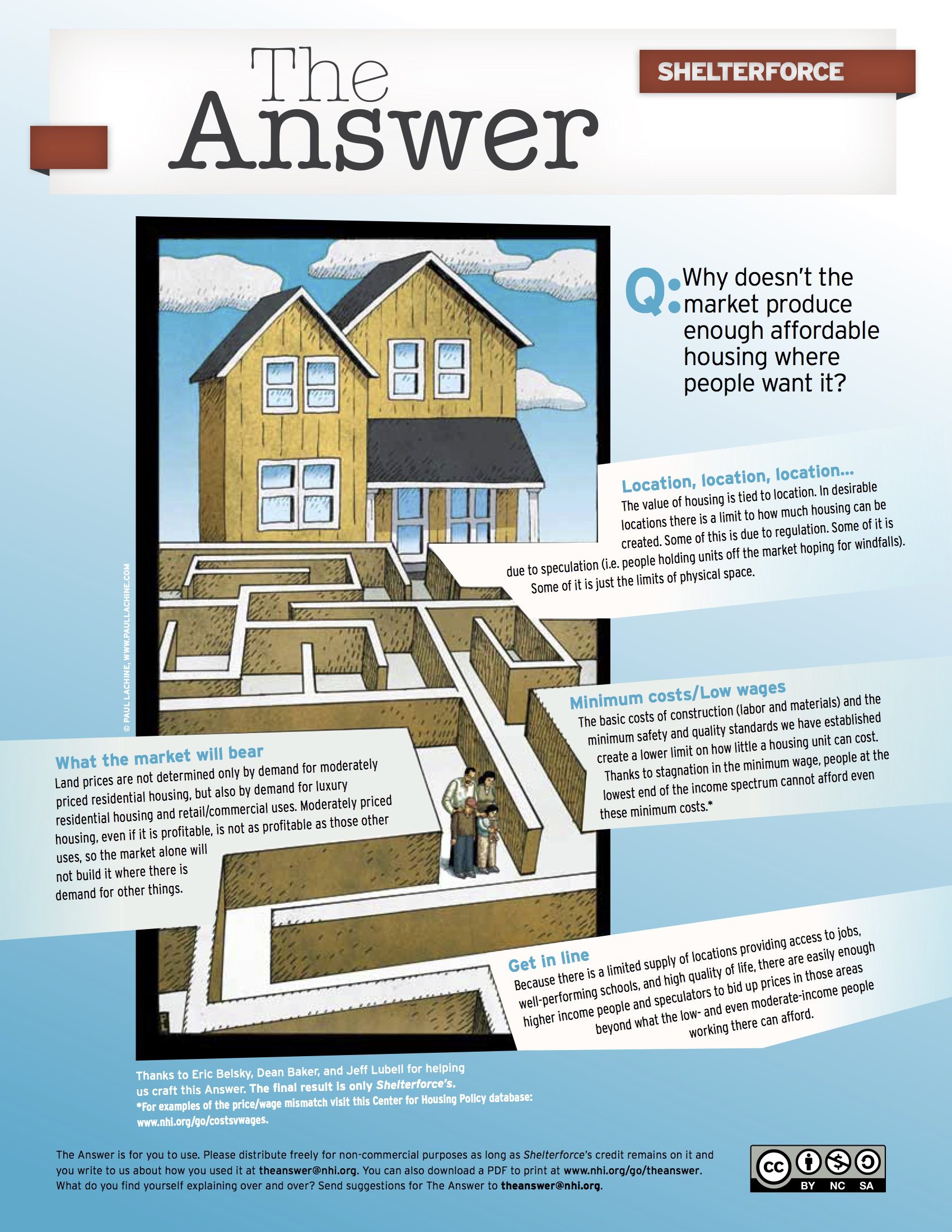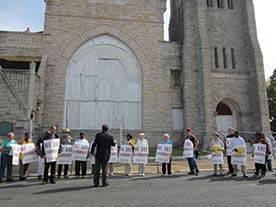
Photo by Richard Feliciano CC BY-NC-ND
During the past quarter century, Jersey City has attracted more than 30,000 jobs and rejuvenated a once-empty waterfront with office and condo towers. Today, this area is home to some of Wall Street’s most famous companies, including Merrill Lynch and JPMorganChase. Goldman Sachs has given the city the distinction of having the tallest office building in New Jersey. Major developers, such as Sam Lefrak and Donald Trump, have built thousands of units of luxury housing by the waterfront, and large hotel chains have arrived along with trendy bars and upscale restaurants.
The skyline by the waterfront, which can be seen from many parts of the city, is testament to this economic renaissance, which has carried over to nearby neighborhoods of row houses and brownstones that have been gentrified. And beyond these neighborhoods, in other parts of the city, luxury apartment houses dot the landscape reflecting the ripple effect of waterfront development.
But that is only part of the story. Many areas of the city have not shared in its remarkable growth. In neighborhoods beyond the waterfront many families struggle to make ends meet on modest incomes in a city with rising taxes, budget deficits, declining services, and failing schools. Almost one fifth of adults and nearly a third of the city’s youth are poor. At the same time, the illegal drug trade, and the crime and violence associated with it, are a constant in lower income neighborhoods. Why didn’t the city’s economic rise benefit more of its residents? What lessons can be learned from such unequal development?
Manufacturing’s Rise and Decline
Because it was a hub for trade and transportation, Jersey City became a manufacturing center during the industrial era. Famous for factories like Colgate and Dixon Mills, the city earned a reputation as a working-class city. It became a place where blue-collar workers and immigrants chased the American Dream of upward mobility and a better life for their children. And for many, especially the white working class, that became a reality. Jersey City’s factories, railroad yards, and warehouses provided the unionized jobs that lifted generations into the working and middle classes.
By the end of World War II, in search of cheaper labor, factories began to leave manufacturing centers like Jersey City for other parts of the country and overseas. Between 1950 and 1992, the number of manufacturing jobs in Jersey City went from almost 40,000 to less than 10,000. From 1982 to 2008, there was an 82 percent decline in manufacturing jobs. By 2008, manufacturing jobs made up only 2 percent of all private-sector jobs and only 3 percent of jobs in general, according to the Urban Enterprise Zone (UEZ) Five Year Strategic Plan of 2010.
The loss of manufacturing jobs had a major impact on Jersey City because of its blue-collar workforce. Its workers depended on jobs that provided entry-level positions for those with limited skills and education. This has remained the case up to recent times, as the UEZ report noted: “Losses in manufacturing are particularly critical since the sector has traditionally provided jobs for new immigrants and persons without higher education credentials. … Close to half of all workers in the sector are Jersey City residents.”
In the decades after WWII, Jersey City not only lost its manufacturing base, but many other kinds of businesses, along with many of its working- and middle-class residents, in the flight to the suburbs. At the same time there were cutbacks in federal and state aid further hindering any chance of a rebound. Jersey City, like so many other cities in the northeast at the time, was in a state of permanent decline for decades.
Jersey City’s Revival in the 1980s
With the decline in manufacturing, the city’s waterfront turned into a wasteland of rotting piers, railroad tracks, abandoned factories and warehouses. Its isolation and deterioration took on an eerie quality and it became a place for youths to seek adventure and engage in mischief. However, by the early 1980s the waterfront once again became attractive to investors. With the national economy emerging from a recession, real estate costs were escalating in Manhattan and developers and corporations were looking for cheaper land and office space. Jersey City’s waterfront, only one mile from lower Manhattan, seemed an ideal solution. Adding to its appeal was its emptiness. As an unoccupied space, it had special appeal for investors who would not have to confront the challenge of displacing residents and businesses. As Arthur Hatzopoulos, former deputy director of the Department of Housing and Economic Development, told The New York Times, “In some ways, developing on the waterfront here is like developing a corn field in Kansas.”
Also in the early 1980s, with its shrinking tax base and loss of federal and state urban renewal dollars, Jersey City, like many other cities, turned to the private sector for capital to finance economic development. It established an Economic Development Corporation to market the city to investors and to offer a variety of tax incentives. This marked the beginning of public-private partnerships that characterized redevelopment in Jersey City and other cities at the time, and which continues today.
In 1983, with subsidies from the city, development began on the waterfront with the construction of an office building at Harborside, a former Pennsylvania Railroad freight terminal. By the mid 1980s, the waterfront area was developing so much and had so many large Wall Street firms that it became known variously as the Gold Coast, Wall St. West, and Manhattan’s Sixth Boro.
The Rise of a Divided Workforce
The waterfront development that began in Jersey City in the 1980s had a transformative effect on the city’s economy and workforce. It signaled a shift from a manufacturing to a service-based economy, which reflected national and global trends. And, as happened in many other cities, its service economy had a particular caste, being dominated by a specific set of industries known as FIRE: financial services, insurance, and real estate. Between 1982 and 2008, employment in financial services in Jersey City increased by 559 percent, going from fewer than 4,500 jobs to almost 29,000. The average wage in financial services in 2008 was $158,000, more than three times the $50,487 average wage for private sector jobs outside financial services in Jersey City.
Unfortunately, the exceptional growth of the financial services industry in Jersey City did not directly provide many job opportunities for Jersey City residents. Most of the new jobs were positions that were already filled and transferred to Jersey City. In 2000, Jersey City residents held only 14 percent of all financial services jobs in the city. In contrast, they held 85 percent of all jobs in the city’s education, health, and services sectors, and over 50 percent of all jobs in construction, retail trade, arts, entertainment, accommodation and food services, and “other services.” With the exception of construction, the sectors in which Jersey City residents predominate are the lower-paying sectors. In sectors in which resident representation is low, such as financial services and professional services, wages are much higher.
The new service economy that emerged to replace the old manufacturing one was bifurcated, made up of high- and low-wage jobs. Those with the appropriate skills and educational credentials had access to high-paying jobs in the service economy while those without were consigned to low paying jobs with few benefits. This is borne out by the growth in income inequality in the city during the past two decades. Between 1990 and 2010, there were major increases in the number of higher-income households and decreases in moderate-income households. The number of households earning at least $100,000 more than quadrupled, while those earning between $25,000 and $50,000 declined by at least one third.
While the financial services industry itself provided few jobs for Jersey City residents, its presence created a demand for a variety of services that resulted in some new jobs for residents. However, these new jobs were in the lower-paying sectors of the service economy overrepresented by women and minorities. This has reinforced racial, ethnic, gender, and class divisions in the city.
Waterfront Redevelopment and the Housing Divide
On the waterfront in the 1980s, alongside corporate towers rose luxury housing apartment buildings matching their corporate cousins in style and opulence. It would be a sign of things to come as luxury housing became the dominant form of new housing built for decades as financial services came to rule the city’s economy. The city’s preference for luxury housing, as well as its limited commitment to more affordable housing, is captured in this assessment in the UEZ strategic plan:
Most of the city’s new housing development has taken place along the waterfront and in the Historic Downtown area, with the majority of new units upscale condos and rentals. But, housing construction and rehabilitation are also energizing other neighborhoods as well.
Sam Lefrak, one of New York City’s major real estate developers, built one of the first and biggest luxury housing developments on the waterfront. He created a series of retail, office, residential, and entertainment facilities on a 600-acre tract of land that became known as Newport. In 1986, rents at Newport for a one bedroom apartment ranged between $900 and $1,000 and the average income of renters was $60,000 a year. Not surprisingly, over half of the tenants came from other areas of New Jersey and almost half came from New York City, with half of those from Manhattan.
Newport’s physical and social distance from the rest of Jersey City made it seem like a separate city. That’s what Sam Lefrak had in mind when he first named his luxury complex Newport City, until Jersey City’s mayor said he would have to drop the “City” part since that area was already part of Jersey City. However, the exclusive nature of the waterfront as a community set apart from the rest of the city with its Wall Street firms and emphasis on upscale housing for professionals, as well as trendy bars and upscale restaurants, still made it seem, as Dennis Hevesi put it in The New York Times, “a city within Jersey City.”
Luxury housing was the only kind of housing built on the waterfront because developers found it most profitable and local politicians did not want to challenge them. Although developers refused to include affordable housing units in their luxury housing developments, they agreed to contribute funds for affordable housing to be built elsewhere in the city. While this provided more resources to build more affordable homes, it also further segregated the city along race, ethnic, and class lines.
In the 1970s, before the development of the waterfront, neighborhoods adjacent to it caught the eyes of many young professionals. Their brownstones and red brick townhouses, with their architectural details and bargain prices, were very appealing to young couples feeling squeezed by the real estate market in Manhattan. At the same time, the city was auctioning many of these properties that had fallen behind in taxes or been abandoned.
With the development of the waterfront and its influx of professionals, the demand for this kind of housing stock increased dramatically. Housing costs in these neighborhoods shot up, resulting in the displacement of many Latino, Filipino, and Polish residents who had lived there for generations. Local urban renewal projects contributed to pushing these residents from their homes and, according to a report by Chester Hartman, led to Jersey City having one of the nation’s highest rates of displacement. Residents fought against displacement and won some important concessions, but ultimately could not stop the forces of gentrification.
By the mid 1980s, the effects of downtown and waterfront redevelopment were being felt across the city in many working-class neighborhoods as housing costs began to escalate. Real estate taxes and rents rose with property values making it difficult for many to stay in their homes. And many landlords, inspired by new condo developments downtown, began to convert their rental units into condos. This resulted in the displacement of more tenants who could not afford to buy their apartments and who were forced out into a higher rental market. This was noted in a study of condo conversions in Jersey City in 1988 by the Department of Housing and Economic Development, which found that “a typical tenant could not afford to purchase his home and faced a substantial rent increase in a new apartment.”
The city’s long-term policy of favoring luxury housing over affordable housing can be seen in housing data for the last decade. From 2000 to 2009, the number of apartments renting for $1,000 a month or more tripled. In contrast, those renting for less than $500 a month declined by more than half.
The sharp decline in affordable housing has meant that many residents are now paying a much higher proportion of their income on rent than before. According to the Census, in 2000, over a third of renters (37 percent) and homeowners (35 percent) spent 30 percent or more of their household income on housing. By 2010, it had grown to half. This growing burden has fallen more on lower income families. In 2008, 79 percent of households earning less than $20,000 a year were spending over 30 percent of their income on rent, in comparison to 4 percent of households earning $75,000 and above.
In promoting and subsidizing the development of luxury housing, the city neglected the needs of most residents for affordable and mixed-income housing. This has led to a permanent housing crisis that has been costly for the city and its residents.
The social and economic inequality that has characterized Jersey City’s redevelopment was reinforced by hurricane Sandy in 2012. While many residents of Jersey City were hard hit by hurricane Sandy, those with the least resources were most affected. Those with the means to escape left or had the resources to cope with the storm’s aftermath. However, in a city where so many live in or near poverty and rely on public transportation, and have no health or homeowners insurance, there was no escape. Many, trapped in buildings without power and running water, were left behind and alone to cope with the storm and its effects. The city’s black residents in Wards F and A certainly felt this way. Several days after the storm, about 50 residents from these communities demonstrated at City Hall over feeling neglected as other neighborhoods were regaining power and services. For them, it was just another example of unequal treatment.
Lessons from Unequal Development
What can community activists and policy makers in other cities planning redevelopment projects learn from Jersey City’s experience? What approaches or steps can they take to ensure that the benefits of new development are spread more equitably, avoiding the social and economic costs Jersey City has incurred?
Tie New Development to Jobs for Residents
Any new development subsidized by the government must provide jobs for residents. Tax breaks for new businesses must be contingent upon hiring a significant percentage of local workers, especially people of color. Job opportunities for local residents should not only include temporary construction jobs but also permanent positions with new businesses. Agreements to hire and train local workers must be binding, strictly enforced, and contain severe penalties for noncompliance. Government must provide sufficient resources to implement, monitor, and enforce labor agreements and utilize its power to halt those projects not in compliance. Representatives of the city’s diverse communities must be included in the design, implementation, and enforcement of labor agreements at every stage of the process. In addition, progress reports on each stage of this process must be made public. In Jersey City, many job opportunities were lost to local residents, especially minorities, because the city failed to hold developers and corporations accountable for their labor agreements. This can be avoided if ironclad labor agreements are negotiated.
Make Affordable Housing a Priority
If local community activists and officials make affordable housing a priority, developers will build it because it will be the “only game in town.” This will require the same political will and resources that many city governments put into the creation of luxury housing. This includes using public land and buildings to create affordable housing rather than selling them off to the highest bidder. Local government should work directly with nonprofit and for-profit housing developers to develop affordable housing on a scale equal to that of luxury housing development and in prime areas of the city.
Making affordable housing a priority means that luxury housing developers who receive tax abatements must include on-site affordable housing units as well. They should not be allowed to buy their way out of their commitment by contributing to a housing fund to build affordable housing elsewhere as has occurred in Jersey City. This option in Jersey City has further segregated residents along racial, ethnic, and class lines.
Preserving existing housing is one of the best ways to keep housing affordable. Limiting or preventing the conversion of rental units into condos is one of the most effective ways to do this. It keeps housing costs stable and allows working- and middle-class residents to remain in the city. There should be moratorium on condo conversions. While municipalities may not have the power to enact such a moratorium, they can play a leadership role in lobbying the state government to do it.
Focusing public policy on making sure that housing and job opportunities for local residents are a priority makes it more likely that the benefits of redevelopment will be shared more broadly, leading to more sustainable growth and social solidarity as more residents feel included in their city’s prosperity.





Comments